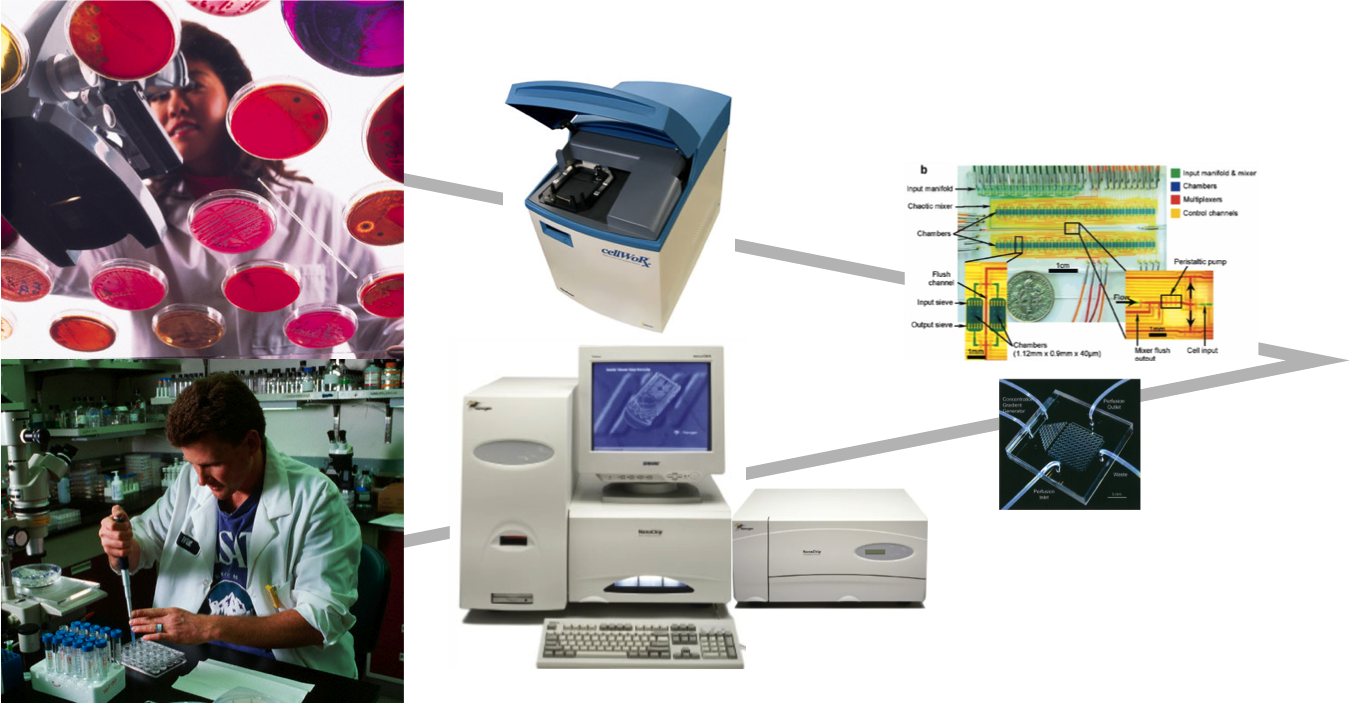Microfludic biochips
I do research on methods and tools for the programming, compilation, modeling, simulation, physical design and control of microfluidic biochips.
Microfluidic biochips (also known as lab-on-a-chip) are an alternative to conventional biochemical laboratories, and are revolutionizing many application, such as such as molecular biology procedures, DNA analysis, proteomics (the study of proteins) and clinical pathology (diagnostic of diseases). They are becoming increasingly complex, with thousands of components, but are designed manually (called bottom-up full-custom design), which is extremely labor intensive and error prone.
Background
Application areas: diagnostics (video) and life sciences (video).
Continuous-flow (see the videos on the page), based on the manipulation of continuous liquid through fabricated (video) micro-channels, using external pressure sources or integrated mechanical micro-pumps.
Background slides on our current research topics on continuous flow biochips.
Droplet-based, in which the liquid is manipulated as discrete droplets on a two-dimensional array of identical electrodes. Basic microfluidic operations, such as mixing and dilution, are performed on the array, by routing the corresponding droplets on a series of electrodes.
Results
PhD thesis: Wajid Hassan Minhass, System-Level Modeling and Synthesis Techniques for Flow-Based Microfluidic Large-Scale Integration Biochips, 2012. Download the thesis or the slides
PhD thesis: Mirela Alistar, Compilation and Synthesis for Fault-Tolerant Digital Microfluidic Biochips, 2014. Download the thesis or the slides.
The work has received a Best Poster Award.
PhD thesis: Elena Maftei, Synthesis of Digital Microfluidic Biochips with Reconfigurable Operation Execution, 2011. Download the thesis or the slides.
The work has received a Best Paper Award.
Simulator for flow-based biochips. Download the software and the master’s thesis.
Master’s thesis: Kasper Understrup, Programming and Control of Flow-based Microfluidic biochips. Download the thesis
The work has received the Embedded Skills Award, see also this news piece.
I have organized several tutorials and special sessions:
Minisymposium organizer, 37th Annual International Conference of the IEEE Engineering in Medicine and Biology Society, Milan, Italy, 2015
Special session organizer, 20th IEEE European Test Symposium, Cluj-Napoca, Romania, 2015
Special session organizer, 28th International Conference on VLSI Design and 14th International Conference on Embedded Systems, Bangalore, India, 2015
Tutorial organizer, IEEE International System-on-Chip Conference (SOCC), Erlangen, Germany, 2013
Special session organizer, International Conference on Hardware/Software Codesign and System Synthesis (CODES+ISSS), Taipei, Taiwan, 2011
Tutorial organizer, IEEE/ACM/IFIP Embedded Systems Week (ESWEEK), Taipei, Taiwan, 2011
All our publications and presentations in this area can be downloaded from here.
Please contact Paul Pop if you are interested to obtain the software we developed as part of this research.
Research
The challenges facing biochips are similar to those faced by microelectronics some decades ago. A typical microprocessor today has over a billion transistors. Such a design complexity is possible because engineers are using Computer-Aided Design (CAD) tools, which, starting from a specification of the desired functionality, automatically build the best possible design (such a process is called top-down design). As in the microelectronics area, CAD tools will reduce the development costs, increase the design productivity and yield, and are the key to the further growth and market penetration of biochips. My research vision is to develop a design flow for biochips, which, starting from a system specification can automatically derive a physical biochip design
Although biochips are becoming complex, with thousands of components, the current programming practice is to expose all of these components to the biochemist end-user, who has to control individually each component to implement the protocols. This is like programming computers by toggling individually each transistor. This approach requires expertise in microfluidics and in hardware/software engineering (besides biochemistry), it is very time consuming and error prone, and makes it impossible to optimize the use of expensive agents and hard-to-obtain samples. In addition, any errors in the biochip will result in a costly protocol failure. My research vision in this area is to bring biochips to the same level of programmability as computers.
